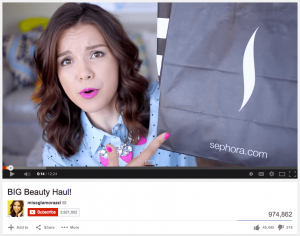Why do micro-influencers matter?
How to use micro-influencers to promote your business
Common challenges with micro-influencers
Are micro-influencers worth it in the end?
Welp. The time has come. Instagram influencers now make up a $1.2 billion dollar market. Snapchat? Another $1 billion. Youtube? You guessed it. And with more than 2.57billion active users combined scrolling through feeds and watching videos, it’s no wonder prices are starting to rise for working with these internet celebrities. When we studied macro vs. micro influencers, account with 100k followers can charge up to $12,500 per post (depending on its engagement).
Let’s start at the beginning
Here’s the catch. Engagement starts to flatten out the more followers a user has. If you have between 1000-8000 followers, you could see an engagement rate as high as 9%. But the more you grow, the more users just aren’t as into interacting with a celebrity as with someone they can relate to more closely. That’s not to say it doesn’t happen, but engagement drops more than half to 3% when accounts have more than 100k followers.
That’s not to say engagement is the end all be all. Maybe you want to get the highest brand awareness possible. If so, then celebrity influencers will definitely do that for you. But, there is an emerging trend has entered the marketing arena: Micro-influencers. And guess what? They have more value for marketers than any celebrity.

Micro-influencers are more beneficial for marketers to work with.
Why do micro-influencers matter?
Even if micro-influencers have far fewer followers or subscribers than their celebrity counter-parts, using them to promote online store or product can be more profitable. As a matter of fact, you can use micro-influencers for pretty much any product. The trust and close relationships these influencers create with their audience really helps drive purchasing decisions. So, why exactly should brands and companies choose micro-influencers?

Three simple statistics:
- 2-5x the engagement rate: less followers means more attention micro-influencers can give their users
- 10x the sales: compared to celebrities, micro-influencers are able to drive more sales because of the attention they give to their followers
- 22x the shares: they’re still influencers! Which means they’ll push your brand further than normal user reviews.
Because they are personally invested, micro influencers are trusted (and adored) by their followers.
Using Micro-Influencers to help promote your business
Find the influencers that already like your brand or product
The best types of influencers are those who are already fans of your brand. When they promote products or services from your brand, it’s more trustworthy because their followers know that the influencer already loves your products. The best part is that you won’t have to put in too much effort to convince them to become your brand advocates.
Let the influencer tell their story
If you really want to promote your brand through micro-influencers, a simple photo featuring your product isn’t going to cut it. And Influencers know that. For the content to really reach and resonate with your target audience, the influencer needs to tell a story around the brand or product. So give them the creative freedom to tell their story. That’s why their followers love them.
Run an ongoing campaign.
A one-off campaign may be sufficient to promote an upcoming product launch or to drive more sales. But real long term success comes from creating ongoing campaigns for influencers to continuously push your product. This is huge for two reasons. 1) It gets your product more consistently in front of your target audience, and 2) It’ll exponentially increase your sales.
Common challenges with micro-Influencers and how to solve them
Here are some common issues and problems people run into when wanting to start a campaign or work with influencers.
It’s too manual of a process to find these micro influencers.
It takes forever to create a comprehensive list of micro-influencers to target. No social media platform really has a great way to quickly pull a list of users for a given keyword or niche and filter by follower count. But there are a few tools to help. Followerwonk is a great tool to find twitter influencers. Buzzsumo helps you find influencers with blogs and great social engagement. And of course there’s Sapie Space (shameless plug!). Another great way is to look at people who already follow your accounts. Are any of them micro-influencers? You’d be surprised. Odds are if they are already fans of your product, they may not cost you anything to run a campaign with.
Engagement can be faked.
This is true. On instagram and twitter, fake comments and “follow for a follow” are a huge issues. For twitter, it’s against their terms of service. For Instagram, they just don’t count any comment with less than four words as legitimate engagement. So how do you get around that? A great way to judge if an influencer is legitimately engaged is to check if they respond to comments in their posts, and to see if they post legitimate comments in other users’ accounts. Your gut is a great judge of character when it comes to legitimacy. Don’t ignore it!
How do you even measure real results?
The best way to make sure you’re successful is to measure results. There’s a few ways to do this. One way is to create a unique landing page. EG: yourwebsite.com/influencer. This gives the influencer an easy place to point their followers, and if you’re offering a special deal to their followers, it’s a clean solution for you to use. But if you’re engaging a lot of influencers in one campaign. Using url parameters is an easy and scalable way to track results. Problem is they can be long and look ugly. Bitly is the key to solving that issue. It’s a url shortener, and easy for influencers to copy and paste into posts or link to in their bio. It’s also short, so you don’t run into character limit issues on Twitter.
Micro-influencers require more of your attention but are definitely worth it.
A single mention on a post might not be enough to really drive a high return on your investment. Especially because micro influencers require more investment in time than just paying a ton of money to a celebrity for a quick endorsement. It requires building a relationship with each influencer, brainstorming how to be both consistent with your brand and also give them creative freedom. And finally it requires setting up the proper tracking so that you can be sure you’re successful.
But there’s a lot of benefit in building long-term, genuine relationships. Feel free to have open conversations with influencers about creating a developed guideline on brand and campaign goals, but make sure to take their feedback and give them creativity. Ultimately having a strong relationship with a large group of micro-influencers will pay off in the long run.









